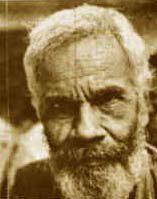04
Nagarjun was born as Baidyanath in a Maithil Brahmin family
of Mithila region of Bihar in 1911, he grew to become a restless
traveler, a Sanskritist, classicist scholar, poet and religious
rebel. He came under the spell of the anti-colonial nationalism
and joined the revolutionary peasant movement led by Swami Sahajanand
Saraswati. He wrote in Maithili under the pen name ‘Yatri’ (Hence
the name Baidyanath Mishra ‘Yatri’). His association with the legendary
Hindi litterateur and Buddhist scholar Rahul Sankrtyayana led him
to travels to Sri Lanka and conversion to Buddhism. He became a
communist at the same time and started writing in Hindi under his
new Buddhist name Nagarjun.
Early on, he was disillusioned by the great compromises and the
dilution of the revolutionary agenda effected by the national leaders.
He started writing about the middle-class character of Congress-led
nationalism and its disastrous implications for the poor peasantry,
artisans and labouring classes. He was jailed for his political
and agitational activities several times before as well as after
Independence.
Though always a well-known a popular poet and writer he was ignored
by the conservative literary and critical establishment for a long
time—till the great cultural upsurges in the Hindi speaking north
Indian belt in late 60’s and early 70’s broke down the old literary
order and turned writers like Nagarjun, Muktibodh, Shamsher Bahadur
Singh, Trilochan and Raghuvir Sahay into cult figures. Nagarjun
also became the poetic voice of the famous Bihar Movement led by
Jayaprakash Narayan and was put behind the bars by Indira Gandhi’s
Emergency Regime. He became a popular hero and cause celebre
of Resistance movement against the Emergency. He soon got disillusioned
with the right wing tilt and politically dubious character of the
leadership of the ‘Total Revolution’, i.e., Bihar Movement, which
he openly critcised and immortalised his critique in a collection
of poems called Khichri viplav dekha hamne (Witnessing a
hotchpotch insurrection). In the succeeding years he continued his
creative onslaught on the establishment.
Baba’s lasting contribution to Hindi poetry is in his attempt to
give a public face to contemporary poetry which otherwise has tended
to get more and more personal, private and introvert. He also brought
to it the force of the tradition, which he freely manipulated to
serve his radical purpose. He also set an example for the intelligentsia
by sticking to the lifestyle of a fakir—bereft of all unnecessary
trimmings of middle class existence and his readiness to rub shoulders
with the ‘riffraff’ with whom he always identified himself.
Baba’s works include: Baba Batesarnath, Balchanma,, Ratinath
ki Chachi; (Novels); Patrahin nagna gachh, Khichri viplav
dekha hamne; translations of Jayadeva’s Gita Govinda,
works of Kalidasa and many other classical works of Sanskrit literature.
Poems of Baba Nagarjun |

Nagarjun
1911-1998
The grand old man of post-Independence Hindi literature, lovingly known
as 'Baba' all over north India, is no more. He died on 5th November
1998 in his native town of Darbhanga, Bihar. There will never be a
Baba again. For some time to come contemporary Hindi poetry and prose
is bound to look like patrahin nagna gachh (leafless naked
tree), which incidentally was the title of one of his later books
of poems.
We dedicate this fourth issue of our magazine to his memory. We
present a short selection of his poems,
to which we hope to add a substantial number in future.
|
|